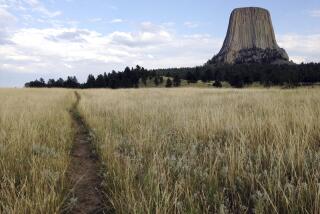Nevada Project Stirs Up a Gold Mine of Trouble
On a high-desert mountain where prospectors first struck it rich in the 1860s, the largest gold-mining company in the world plans a major expansion that critics say could change the way the U.S. government regulates toxic mining waste.
Newmont Mining Corp.’s proposed $200-million Phoenix project would cover nearly 10 square miles of northern Nevada, reclaiming parts of an existing 3,000-acre contaminated site and spreading gold-mining operations over an additional 4,300 acres beginning in 2006.
The open-pit project would be the first major U.S. mine to post money in a new environmental trust fund required under controversial regulations that President Clinton ordered on his last day in office.
The Denver-based company’s plans are drawing criticism from conservationists and pitting two federal agencies against each other.
The Bureau of Land Management backs the project but the Environmental Protection Agency agrees with a watchdog group’s claims that the company is dramatically underestimating the potential costs of environmental risks over tens of thousands of years.
“They are predicting acid will drain off the site for 20,000 years,” said Tom Myers, a hydrologist and executive director of the environmental group Great Basin Mine Watch.
“It’s the first place in the country the mining industry is proposing long-term treatment of predicted acid mine drainage,” he said. “It’s perpetual treatment, and we do not condone perpetual treatment.”
The government’s new trust fund is intended to protect U.S. taxpayers by setting aside money to address any ill effects that might be detected in the years after a mine plays out and the company restores the site.
In this case, the fund would be used if pollution resulted from water passing through waste rock, some of which Newmont intends to use to help refill the open pit. The leftover rock, although inert underground, contains acids that are released when exposed to the elements.
“I’m not really worried about Newmont going away, but if they sell it to ‘Joe Bob Mining’ when the site is essentially mined out, that worries me,” Myers said.
Newmont officials acknowledge that sulfuric acid could leak far into the future but insist that state-of-the-art reclamation practices would minimize risks at a mine that promises to bring 270 jobs to a depressed rural mining area.
Nevada ranks third in the world in gold production behind South Africa and Australia, but the mining industry has struggled in recent years. Mining jobs in the state dropped from nearly 15,000 in the mid-1990s to fewer than 9,000 in 2002, according to the Nevada Mining Assn.
Newmont is confident that the new trust fund -- besides the usual bond posted to cover reclamation costs -- will safeguard the environment.
“It’s a contingency for what we think is highly unlikely. We think we have a real sound project there,” said John Mudge, Newmont’s director of environmental affairs.
Just how big of a contingency is being disputed by the EPA, which fears toxic leaks, and the BLM, which believes that leaks are unlikely.
Newmont maintains, and the BLM agrees, that a $408,000 trust fund, backed with additional investment in a $1-million surety bond, is sufficient.
The EPA says $33 million is closer to the mark. The BLM’s decision can be appealed through March 20.
“It’s a huge disagreement -- a big discrepancy for a very big project with a very large potential for impacts,” said Jeanne Geselbracht, an EPA specialist who reviewed the BLM’s environmental studies. “They’re proposing only about 1% of what we think is needed to start out the trust fund and make sure taxpayers don’t get stuck with the bill.
“It looks like a pretty sure thing that there will be groundwater contamination and that they will need to use the money. It could become a Superfund site,” she said from San Francisco.
The huge open pit is carved into the side of Battle Mountain about 12 miles south of the town of the same name on Interstate 80, about 200 miles east of Reno. Dozens of mines have opened and closed there in the 140 years since the minerals beneath the 8,200-foot peak were first tapped.
“There is no more sacrificed mountain in this state than this mountain here,” Myers said during a recent aerial tour with LightHawk of Lander, Wyo., a group of volunteer environmentalist pilots who fly news reporters on observation flights.
The Mine Watch doesn’t want to block the project -- just up the ante in the trust fund, Myers said.
The group warned the BLM that the project will dry up streams, pollute surface and groundwater, cause substantial toxicological threats to wildlife and likely end up on the EPA’s Superfund list.
“They have predicted pollution will occur at several locations as water drains through the waste rock that will be left behind. They basically are predicting this kind of thing will get into the groundwater,” Myers said.
Newmont has agreed to post a bond to cover $237 million in reclamation costs to return the site to its condition before mining. That money would be returned within 30 years if the work is completed on schedule.
As for the discrepancy between the BLM and EPA trust fund estimates, “anybody can do anything they want with numbers,” said Gail Givens, the BLM’s assistant field manager for nonrenewable resources at Battle Mountain. “Even if we are wrong, we have safeguards built in to make it right,” including a review of the fund status every three years.
Computer modeling suggests that acid rock drainage could find its way into the water table, Givens said. But he said a thick cap of soil and vegetation planned to cover the waste rock piles will keep water, rain and snow from reaching the rock.
“The modeling said it was possible [acid would leak] -- that 60 years after mining it could happen. But we really don’t anticipate a large problem there,” he said.
Geselbracht said EPA officials described in meetings with the BLM how they calculated cleanup costs but never received a good explanation from their counterparts about the discrepancy in cost estimates.
“They just disagree with us. They took the number they were given by Newmont,” she said.
The EPA has been raising concerns about the project for more than three years. Groundwater at the site is already contaminated with arsenic, cadmium, copper, nickel, zinc, selenium, mercury, beryllium and chloride, the agency said.
Laura Yoshii, acting EPA regional administrator, warned the BLM in May 2001 about the plan, and EPA Regional Administrator Wayne Nastri repeated in November 2002 that the project “will likely create a perpetual and significant acid mine drainage problem requiring mitigation for hundreds of years.”
Mudge said the existing contamination is one of the reasons that Newmont wants to repair the site and expand with more efficient, modern mining practices.
“This is our chance to go in and really mine this area out, reclaim and close out all the existing areas,” he said. “I can’t emphasize enough how it is going to improve the environment out there where a lot of historic mining has been taking place.”
The business plan calls for 13 years of mining, although the federal permit allows 28 years.
More to Read
Sign up for Essential California
The most important California stories and recommendations in your inbox every morning.
You may occasionally receive promotional content from the Los Angeles Times.










